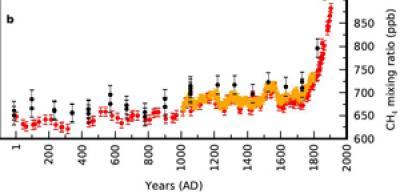Methane is an underestimated greenhouse gas, 23X the impact of CO2 but not as long-lived, and like CO2 it has natural sources and also originates from human activities. The emissions from natural sources varies due to \climate variations; as an example, bacteria in wetlands release methane and less is emitted in dry cycles when wetlands shrink.
Emissions of methane are also not entirely natural; rice fields are wetlands and methane is emitted from biomass burning that is not accidental, such as the use of wood in furnaces. Energy production through coal combustion also produces methane gases.
Determining where the methane gas comes from has been more magic than science but modern methods can narrow it down.

Methane hockey stick. The isotope curve shows that the emissions of the greenhouse gas methane had several peaks in the last 2,100 years. 1: During Roman times, where a lot of wood was burned for heating and for the processing of metals. 2: During the warm Middle Ages, where forests caught on fire. 3: In the "Little Ice Age", which was a very cold and dry period. 4: The methane concentration has increased dramatically since approx. the year 1800, when industrialization took off and triggered energy and food production, for example, rice fields. Credit: NBI
"The different sources of methane have different isotopic compositions. The methane produced by the burning of biomass, like wood, contains more of the heavier isotope (carbon-13) relative to the lighter isotope (carbon-12), than methane which is produced in wetlands," said Professor Thomas Blunier of the Centre for Ice and Climate at the Niels Bohr Institute at the University of Copenhagen in a statement. He and others have measured the isotopic composition of the methane in ice cores that are drilled up from the Greenland ice cap at the NEEM project in northwestern Greenland. The ice cap is formed from snow that falls year after year and remains, gradually getting compressed into ice. The ice contains tiny air bubbles from the atmosphere in the snow that fell, and by analysing the composition of the air you can get a climate curve, which tells you about both the annual temperature and methane content.
The question is how far back in history man has had an impact on the methane concentration in the atmosphere?
"We have analysed the methane composition more than 2,000 years back in time. We can see that already 2,100 years ago during Roman times, some cultures were spreading out and burning large amounts of wood for fuel in furnaces to work with metals that required intense heat to process. But the level was still low. The next significant increase was during the Middle Ages around 1,000 years ago. It was a warm period and it was dry so there were presumably many forest fires that emitted methane while the wetlands dwindled and reduced methane emissions from that source. We also find emissions from natural forest fires and deforestation during the so-called 'Little Ice Age' (between 1350 and 1850), which was a very cold and dry period, Emissions of methane increased dramatically from around 1800, when the industrial revolution took off and where there occurred a large increase in population," says Blunier.
Published in Nature






Comments